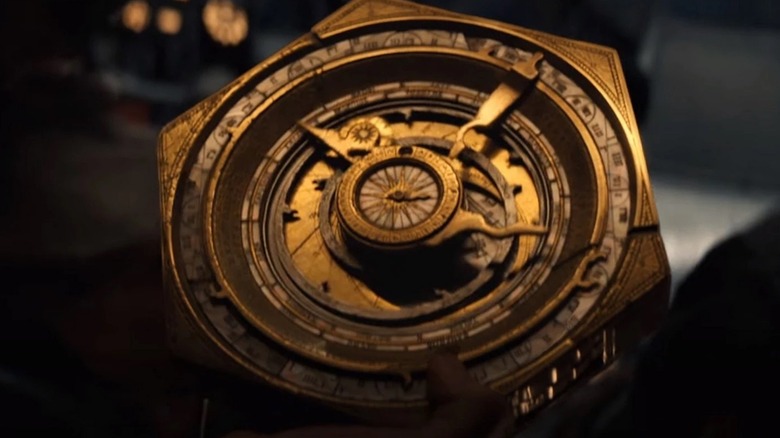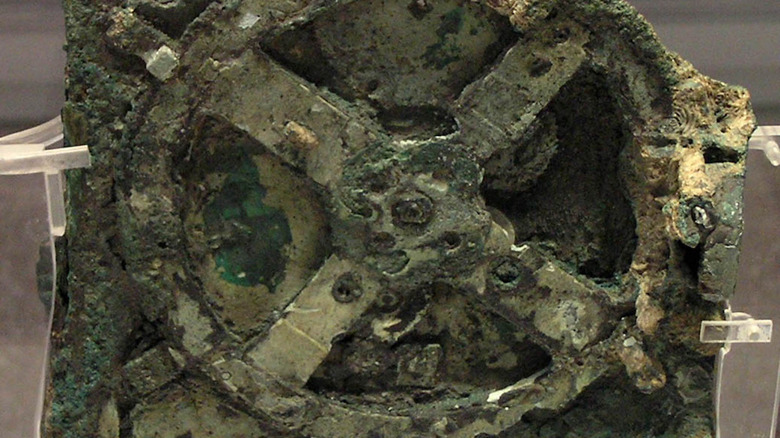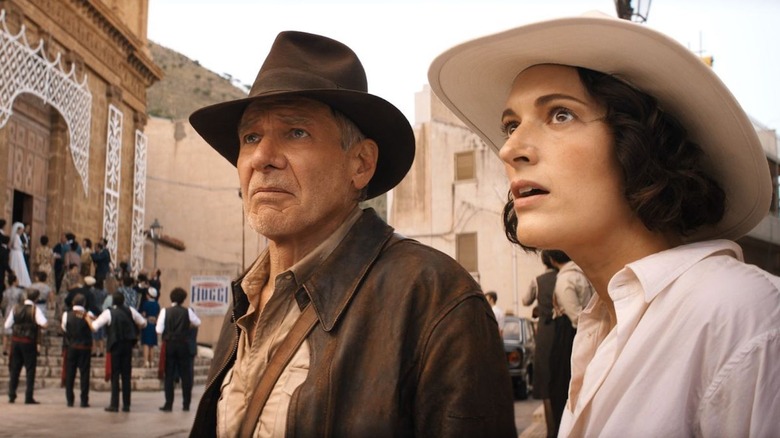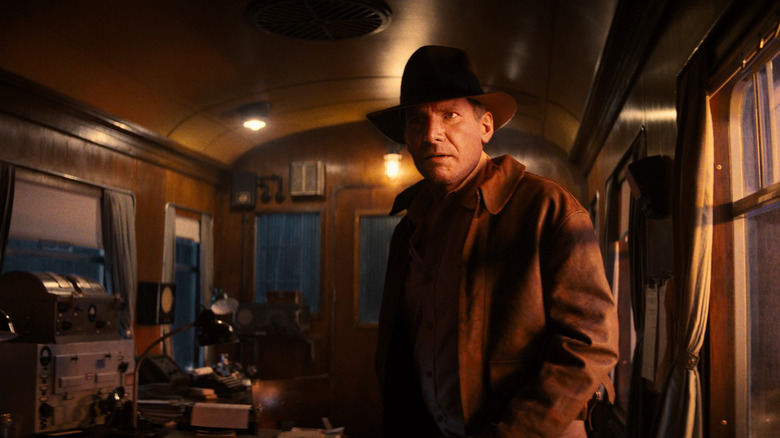Here's How The Dial Of Destiny Works In Indiana Jones (You Need To Do A Little Math)
This article contains spoilers for "Indiana Jones and the Dial of Destiny," so beware.
Alfred Hitchcock coined the term MacGuffin, declaring it "the thing that the spies are after, but the audience doesn't care." In the "Indiana Jones" saga, all of the installments center around a MacGuffin, a mysterious artifact central to the story. In "Raiders of the Lost Ark," Indiana Jones quests after the coveted Ark of the Covenant. In "The Temple of Doom" he goes after the fabled Sankara Stones. The Holy Grail is at the center of the race in "The Last Crusade." "The Kingdom of the Crystal Skull" revolves, naturally, around the Crystal Skulls of pre-Colombian Mesoamerican origin. But what is the Dial of Destiny and how does it work?
In "Indiana Jones and the Dial of Destiny," we learn that the titular device is actually the Antikythera, designed by Archimedes, one of the most prominent astronomers, mathematicians, physicists, engineers, and inventors in classical antiquity.
Some have left the movie scratching their head about how the device works, but few realize it's based on a real object, just like the MacGuffins in other Indy pictures. So, what is it based on and how does it work? That's what we're here to learn.
The Real Antikythera Mechanism
The Antikythera Mechanism is real, an ancient Greek relic recovered in 1901 in a shipwreck off the coast of the island of Antikythera. It's a hand powered orrery — a mechanical model of the solar system that can predict eclipses and other astronomical positions, including those of the moon, in advance. It also tracked the four-year cycles of the ancient Greek Olympics.
In order to do this, one would need a detailed understanding of previous astronomical data and the math to predict how it works. This device dates back somewhere from about 200 BCE to 87 BCE.
Similar astrological clocks wouldn't appear again in history until the 14th century, making this an extraordinary discovery that upended human understanding of the history of astronomy and computing. This is believed to be the first analog computer in human history.
In 2008, researchers found other evidence that led them to believe that it might have originated in Syracuse. Given the timing, it seemed likely that it could have been a product of the great mathematician Archimedes or his school in Syracuse.
Unfortunately, without a device to travel in time, we can't know for sure if Archimedes had a hand in its design, but for the sake of such an entertaining motion picture, you have to make some decisions certain.
How it works in the movie
In the movie, the Dial of Destiny doesn't actually open a portal in time, and there's no actual supernatural element to it. It's based purely on the fact that it's an analog mathematical computer that determines the time and place of astronomical anomalies, referred to as fissures in time in the film. It's fitting in a movie where science and the exploration of the moon has overtaken the collective interest of the world that the archeological object Indiana Jones is chasing after is based entirely on mathematics and astronomy.
In the film, Archimedes designed and machined this precision dial that involved all of the math he had devised to predict the cycles of the moon and the Olympics, but with the added element of predictions of fissures in time in the sky. They are like eclipses, fixed points in time and don't differ because it's simply math. Archimedes wouldn't have been able to get to these fissures in the sky, but he would have been able to witness enough of them to understand they were heavenly phenomenon that occurred at regular intervals and could work the math out for how often they would happen. It's no different than how we predict eclipses.
And since these were fixed points, there was a closed time loop, preventing history from being changed by the Butterfly Effect theory. They were always destined to go back in time and make those changes, hence the title of the film.
The math involved is why Indiana Jones was so adamant that Archimedes had miscalculated because of continental drift. It hadn't been observed yet, and so his math would be right to a point, but off in catastrophic ways that led the planes heading back to Syracuse rather than pre-war Germany.
A clever MacGuffin
This is an intensely clever MacGuffin for this film and the era in which Indiana Jones is placed in. The entire world has passed him by. In the 1930s and that whole era before, archeology was the hot new thing. Exploring our past was sexy and exciting. Just think about all of the excitement over the discovery of King Tut's tomb in the 1920s and the adventure serials such colonial grave robbing spawned.
In 1969, all eyes turned up to the sky and the moon in time for humanity's landing on the moon. But this curiosity has always been a part of humanity, and archeoastronomy is as fascinating a field as either of its disparate parts. The MacGuffin links past and present both literally and symbolically, giving us a rich tapestry for the story and the characters to fulfill their destinies. It's preposterously well-written and the context it offers the rest of the film only adds to its depth and enjoyment.
"Indiana Jones and the Dial of Destiny" goes back in time in other ways, too, as Helena (Phoebe Waller-Bridge) struggles with the same fortune and glory attitude that plagued Indiana Jones in "Temple of Doom," complete with an underage sidekick. Indy tries to guide her to the lessons his past earned him, but she isn't able to see it. But she sees other things clearly, acting as a catalyst for the ultimate end of the film and a lovely send-off for Harrison Ford as Indiana Jones
The movie works so well, it's astonishing.
"Indiana Jones and the Dial of Destiny" is playing in movie theaters everywhere now.



